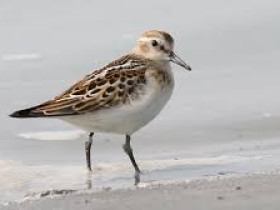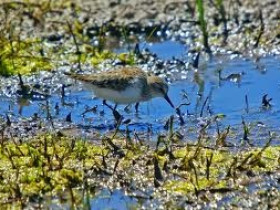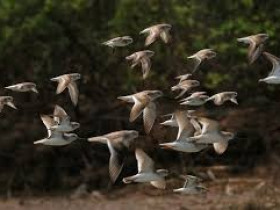Little Stint
Calidris minuta
12-14cm
Appearance of the Little Stint
Smaller than the Dunlin, this wader has short black legs and a short, straight bill. In spring the adult is reddish brown on the upperparts, and it has a hint of a yellow, backwards 'V' on its back. The head and upper breast are reddish, underparts are mostly white, and there's a pale stripe that forks above the eye. The plumage dulls over summer. During winter, the upperparts are grey, the underparts white, and there's a patch of white between bill and eye. Juveniles are the most common member of this species to be seen in the region. They are brownish on top, similar to the summer adult, with two striped markings on the face, pale edges on the wings, white underparts, and a distinctive white 'V' on the back, dividing darker feathers. When flying, there's a white bar on the wing, the outer tail feathers are grey, and the rump is darker in the middle.
Little Stint Habitat
Found predominately on the east and west coasts of Britain, where they may visit the edges of lakes and reservoirs, sheltered estuaries and brackish pools close to the coast. When on its breeding grounds in the Arctic, it favours tundra and large islands, or lakes and river deltas.
Character
Feeds in a frenetic way, focussed on pecking at mud so it hardly seems to look up. Feeding birds establish small territories. After a good breeding season, numbers in a flock may be around 50, but they may dwindle to 10 in a less productive year.
What does the Little Stint eat?
Diet includes insects, particularly flies and beetles, small worms, tiny shellfish, shrimps and plant material including seeds.
Little Stint Breeding
Is not a breeding bird in Britain or Ireland. Female lays 4 eggs in late June and incubation takes 20 days. Some females leaves first clutch to the male while she incubates a second. Young birds can fly after 17 days.
Population
More birds are in the region in autumn than in spring, and most of these are juveniles. Migrants depart Arctic territories in August; juveniles travel along the Atlantic seaboard while adults go via the Mediterranean Basin on their way to Africa. The smaller numbers in Britain in spring suggests the birds take a different route back to the Arctic. Approximately 500-700 individual may travel through Britain in autumn.
Observation Tips for the Little Stint
Bird are at their largest numbers in late August or September, so estuary visits are a good bet around these times. If feeding near Dunlins, check the size; the Little Stint is noticeably smaller, and it also has an almost frenzied way of feeding, which should help separate it from other species.
Voice
May repeat 'stip' about three times if alarmed.



